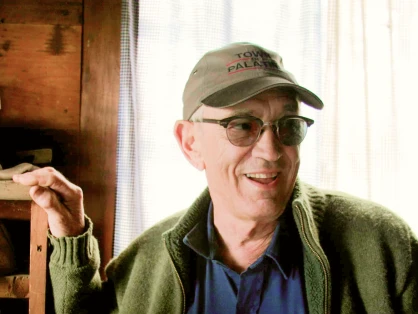The kitchens, pantries, and cellars may have changed through the years but the dedication of those who’s world it was have not. The fireplace hearth where the cooking was done gave way to the cookstove and then to the electric or gas kitchen range. To say nothing of the now indispensable microwave. The utensils used in early days have mostly become treasured relics to marvel at and admire. High on the display shelf at Fort Plain Free Library some of them now rest to help recall an era lost to most of us. I say most because yet in Amish kitchens some of yesterday remains for those who sit at the meal table with a family who know the mothers and daughters have prepared that dish with the mountain of mashed potatoes, the creamed corn, meat and fruit canned much the same as some of us remember from our youth. Canning, pickling or drying were everyday tasks not well known to today’s housewives.
Let’s take a closer look at this display of yesterday’s implements. My grandpa’s pancake batter pitcher reminds this writer of the mornings’ meals of pancakes and sausage with milk gravy and maple syrup. At this point I hope the reader will excuse the foregoing where the ladies were the only ones mentioned as cooks. Often the male members of the family have been excellent cooks and still are. The iron pancake griddle and pancake turner displayed are from an earlier day when it, along with the heavy tea kettle hung from the crane in the kitchen fireplace. The andirons and long handled frying pan served the Mohawk Valley Seebers family in early days. Those long handles kept the cooks from the heat of the fire. You might want to make your breakfast toast in the swivel bread toaster which the blacksmith ornamented with skilled hands.
Can you imagine the toast from that toaster being passed to you at Sprakers Tavern where this implement came from? That small iron kettle once held the stew that John F Nellis ladled from it. John was a Stone Arabia farm boy born just the right number of years before the American Revolution that he saw service in the conflict that brought the United States of America into existence. See that brass kettle up there? It was used by aunt Mary to make her famous brass kettle pickles. When you look at the metal utensils in this exhibit you may well realize that they can bring yesterday’s kitchen into view much the same as books or tv programs. We have noted how the blacksmith added some decoration to the utensils he produced. The other artisans of yesteryear did much the same depending upon which material they used. The wood carver embellished his work with animals or other designs from his imagination.
Stoneware jugs and crocks were often ornamented to add a splash of color to everyday life. All of the examples in this exhibit date from the 1800s when crocks were used to hold everything from butter to sauerkraut and pickled meat. What was once in these jugs? The answer could be any thing from maple syrup to vinegar to hard cider or most any other liquid. Birds and flowers were often chosen as decorative features. The birds stare down at us possibly waiting for their modern counterparts to fly by the window. Some stoneware is marked by its makers, often in not far away locations. Others bear the advertising of local stores whose doors were closed a century or more ago.


